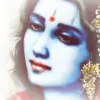I am not familiar with the book you want to read. I can't help you to access it.
Originally posted by: IWasHareeshFan
Nahush married I don't remember whom but I think Aashok Sundari (I am not sure) and gave birth to Yayati.
Aśokasundarī is in Padmapurāṇa. In Mahābhārata, the mother of Yayāti is either Priyavāsas (Ādiparvan 70.28) or Virajas (Harivaṃśa 13.60).
Originally posted by: IWasHareeshFan
Now, the story I know is that Yayati was getting old but could not give up on pleasures of youth and asked his sons to give their youth on loan.
Those who refused to do that were cursed that they will never become the king so the one who refused his descendents were known as Yadavs and the one who agreed was called Puru.
Dhṛtarāṣṭra told Duryodhana a version of the story that doesn't mention youth or old age at all (Udyogaparvan chapter 147): Yadu was proud of his strength, defeated all the governors, and occupied Nāgasāhvaya (elephant-synonym = Hāstinapura), disrespecting his father and brothers, so Yayāti disinherited him and his brothers who followed him, and chose Pūru as his heir.
If we accept that Hāstinapura was named after Hastin, a distant descendant of Pūru, the use of the name Nāgasāhvaya in Yadu's time appears anachronistic.
Originally posted by: IWasHareeshFan
Coming back, my question ki whether Yadavs were named after Yadu? Was Yadu also the son of Yayati?
Yes and yes.
Originally posted by: IWasHareeshFan
Then Puru married Kaushallya and Janmijaya was born.
OK now I don't know who all were born after Janmijaya, I only know that
Tansu married Kalindi and Ilina was born.
Ilina married Rathantari and King Dushyanta was born.
Dushyanta married Shakuntala and Shakuntala gave Birth to Bharata.
But please tell me if you can?
Who all were born between Janmijaya and Tansu and who all were were born after Bharat?
If you know these many details from Mahābhārata - Ādiparvan chapter 90, don't you have access to a translation of the whole chapter? Does your university have a library that can get books on inter-library loan?
Ādiparvan chapter 89 version:
Pūru + Pauṣṭī -> Pravīra, Īśvara, Raudrāśva
Pravīra + Śyenī -> Manasyu
Manasyu + Sauvīrī -> Subhrū, Saṃhanana, Vāgmin
Despite saying that Pravīra was the dynasty-maker, Vaiśaṃpāyana now switches to Raudrāśva to get to Matināra as Pūru's great-grandson. In the next chapter's version, however, it takes twelve "greats" to get from Pūru's grandson's generation to Matināra, without Raudrāśva. And in Harivaṃśa's version, Raudrāśva is Manasyu's great-great-grandson.
Raudrāśva + Apsaras -> Ṛcepu, Kakṣepu, Kṛkaṇepu, Sthaṇḍilepu, Vanepu, Sthalepu, Tejepu, Satyepu, Dharmepu, Saṃnatepu
Ṛcepu -> Matināra (mother unspecified)
Matināra -> Taṃsu, Mahat, Atiratha, Druhyu (mother unspecified)
Taṃsu -> Ilina (mother unspecified)
Ilina + Rathaṃtarī -> Duḥṣanta, Śūra, Bhīma, Prapūrva, Vasu
Duḥṣanta + Śakuntalā -> Bharata
Bharata + 3 women -> 9 sons & Bhumanyu Vitatha
Bhumanyu + Puṣkariṇī (daughter) of Ṛcīka -> Suhotra, Suhotṛ, Suhavis, Suyajus
Suhotra + Aikṣvākī -> Ajamīḍha, Sumīḍha, Purumīḍha
The next chapter's version identifies Suhotra's mother as Jayā Dāśārhī - no match to this version, and his wife as Suvarṇā of Ikṣvāku = Aikṣvākī. It's plausible that Ṛcīka belonged to Daśārha and had a daughter known by both names, Puṣkariṇī and Jayā. However, Ajamīḍha who is Suhotra's son in this version is Suhotra's great-grandson in the next chapter's version, and Suhotra's grandson in Harivaṃśa's version; only one genealogy can be literally correct.
Ajamīḍha + Dhūminī -> Ṛkṣa
Ajamīḍha + Nīlī -> Duḥṣanta, Parameṣṭhin
Ajamīḍha + Keśinī -> Jahnu, Jana, Rūpiṇa
Ṛkṣa -> Saṃvaraṇa (mother unspecified)
Jahnu is identified as the ancestor of the Kuśikas. If we accept that Viśvāmitra was born in this Kuśika family, Viśvāmitra's ancestor was his grandson Bharata. Perhaps the Kuśikas were not one dynasty but whoever ruled the Kauśāmbī area over time, both before and after this Jahnu. I wrote a fan fiction about Bhīṣma in which his mother is Jāhnavī, a descendant of this Jahnu.
"These all-Pāñcālas" belong to Duḥṣanta and Parameṣṭhin. Thus, their son or grandson would have been the Pāñcālya king who defeated Saṃvaraṇa, driving him to the Sindhu river for a thousand years. However, the use of the name Pāñcālya would be anachronistic here if we accept that the Pañcāla country got its name from the coexisting dynasties of five brothers, several generations after Ajamīḍha.
Saṃvaraṇa + Tapatī Saurī -> Kuru
Kuru + Vāhinī Manasvinī -> Aśvavat, Abhiṣvat, Citraratha, Muni, Janamejaya
Abhiṣvat -> Parikṣit, Śabalāśva, Abhirāja, Virāja, Śalmala, Uccaiḥśravas, Bhadrakāra, Jitāri (mother unspecified)
Parikṣit -> Janamejaya, Kakṣasena, Ugrasena, Citrasena, Indrasena, Suṣeṇa, Bhīmasena (mother unspecified)
Janamejaya -> Dhṛtarāṣṭra, Pāṇḍu, Bāhlīka, Niṣadha, Jāmbūnada, Kuṇḍodara, Padāti, Vasāti (mother unspecified)
Dhṛtarāṣṭra -> Kuṇḍika, Hastin, Vitarka, Krātha, Kuṇḍala, Haviḥśravas, Indrābha, Sumanyu (mother unspecified)
At this point, Vaiśaṃpāyana jumps to Pratīpa without explaining how he's connected to the Kuru dynasty. Since the next chapter names Bhīmasena son of Parikṣit as Pratīpa's father, are we supposed to look at Kuru's great-grandson Bhīmasena, grandson of Abhiṣvat and son of Parikṣit? Then Pratīpa was a cousin of Dhṛtarāṣṭra, Pāṇḍu, Bāhlīka etc.; Pratīpa's sons like Śaṃtanu were second cousins of Dhṛtarāṣṭra's eight sons; and those eight brothers' descendants were eclipsed by Bhīṣma etc.
Pratīpa -> Devāpi, Śaṃtanu, Bāhlīka (mother unspecified)
Ādiparvan chapter 90 version:
Pūru + Kausalyā -> Janamejaya
Janamejaya + Anantā Mādhavī -> Prācinvat
Prācinvat + Aśmakī -> Saṃyāti
Saṃyāti + Varāṅgī daughter of Dṛṣadvat -> Ahaṃpāti
Ahaṃpāti + Bhānumatī daughter of Kṛtavīrya -> Sārvabhauma
Sārvabhauma + Sunandā Kaikeyī -> Jayatsena
Jayatsena + Suṣuvā Vaidarbhī -> Arācīna
Arācīna + Maryādā Vaidarbhī -> Mahābhauma
Mahābhauma + Suyajñā Prāsenajitī -> Ayutanāyin
Ayutanāyin + Bhāsā daughter of Pṛthuśravas -> Akrodhana
Akrodhana + Karaṇḍu Kāliṅgī -> Devātithi
Devātithi + Maryādā Vaidehī -> Ṛca
Ṛca + Sudevā Āṅgeyī -> Ṛkṣa
Ṛkṣa + Jvālā daughter of Takṣaka -> Matināra
So, the dynasty from Pūru to Matināra is nothing like the previous chapter's version and nothing like Harivaṃśa's version. The number of Matināra's sons also varies across versions: four, one, or three.
Matināra + Sarasvatī (personified place, probably the river) -> Taṃsu
Taṃsu + Kālindī -> Ilina
Ilina + Rathaṃtarī -> Duḥṣanta etc., total five sons (others not named)
Duḥṣanta + Śakuntalā daughter of Viśvāmitra -> Bharata
Bharata + Sunandā Sārvasenī Kāśeyī -> Bhumanyu
Bhumanyu + Jayā Dāśārhī -> Suhotra
Suhotra + Suvarṇā girl of Ikṣvāku -> Hastin who planned Hāstinapura
Hastin + Yaśodharā Traigartī -> Vikuṇṭhana
Vikuṇṭhana + Sudevā Dāśārhī -> Ajamīḍha
Ajamīḍha + Kaikeyī, Nāgā, Gāndhārī, Vimalā, Ṛkṣā -> 124 sons, many dynasties other than Saṃvaraṇa
Saṃvaraṇa + Tapatī Vaivasvatī -> Kuru
Kuru + Śubhāṅgī Dāśārhī -> Viḍūratha
Viḍūratha + Saṃpriyā Māgadhī -> Arugvat
Arugvat + Amṛtā Māgadhī -> Parikṣit
Parikṣit + Suyaśā Bāhudā -> Bhīmasena
Bhīmasena + Sukumārī Kaikeyī -> Paryaśravas = Pratīpa
Śubhāṅgī the wilful daughter of Vāhin of Daśārha would have been known by both names from this version and both names from the previous chapter's version. However, Bhīmasena's father Parikṣit is Kuru's great-grandson through Viḍūratha and Arugvat in this version; Bhīmasena's father Parikṣit is Kuru's grandson through Abhiṣvat in the previous chapter's version; Parikṣit is Kuru's son, Vidūratha's great-grandfather, and Bhīmasena's great-great-great-grandfather in Harivaṃśa's version; all three can't literally be true.
Pratīpa + Sunandā Śaibyā -> Devāpi, Śaṃtanu, Bāhlīka
This is followed by the story of Śaṃtanu's descendants that you know well, except that Śaṃtanu's first seven children aren't mentioned. Four of Dhṛtarāṣṭra's hundred sons are named as prominent: Duryodhana, Duḥśāsana, Vikarṇa, and Citrasena. (I have collected allusions to a villainous role for Citrasena in my fan fiction.)
With no mention of Arjuna's sons Irāvat and Babhruvāhana, the Pāṇḍavas in this version have eleven sons, of whom only Ghaṭotkaca, Abhimanyu, and the Draupadeyas appear elsewhere.
Yudhiṣṭhira's wife Devikā, daughter of Govāsana Śaibya, is mentioned here, but not when the Pāṇḍavas and their five wives are described in Āśramavāsikaparvan. Govāsana Śaibya fought against the Pāṇḍavas in the events of Bhīṣmaparvan and Droṇaparvan. Sahadeva's wife here is Vijayā Mādrī, who cannot be identified with Sahadeva's wife in Āśramavāsikaparvan, who was Jarāsaṃdha's daughter. Bhīma's wife here is Baladharā Kāśyā, and in Āśramavāsikaparvan, she's called the sister of a royal army-leader who always competed with Kṛṣṇa, which could refer to anyone: certainly Akrūra who was called Kāśya, but also Ekalavya, Rukmin, Śiśupāla, Veṇudāri and other now-obscure enemies, Nagnajit, Bāṇa, Śalya, and in later legends, Pauṇḍraka Vāsudeva. Nakula's wife here is called Kareṇuvatī Caidyā, and she could easily be the same as Dhṛṣṭaketu's sister, who is the wife of an unspecified Pāṇḍava in Āraṇyakaparvan and Āśramavāsikaparvan. (I have collected mentions of Dhṛṣṭaketu's sister in my fan fiction.)
Harivaṃśa chapter 23 version:
Pūru -> Pravīra (mother unspecified)
Pravīra -> Manasyu (mother unspecified)
Manasyu -> Abhayada (mother unspecified)
Abhayada -> Sudhanvan (mother unspecified)
Sudhanvan -> Subāhu (mother unspecified)
Subāhu -> Raudrāśva (mother unspecified)
Raudrāśva -> Daśārṇeyu, Kṛkaṇeyu, Kakṣeyu, Sthaṇḍileyu, Saṃnateyu, Ṛceyu, Jaleyu, Sthaleyu, Vananitya, Vaneyu, and ten putrikā-women (daughters whose progeny were legally Raudrāśva's): Rudrā, Śūdrā, Madrā, Maladā, Malahā, Khalā, Balā, Taladā, Gopabalā, Ratnakūṭā (mother unspecified)
Here appears the story of the ten sisters' husband, ṛṣi Prabhākara of Atri lineage. His son by Rudrā was Soma, and his ten sons who had the same names (as their mothers) were the SvastyĀtreya ṛṣis. This is followed by the descendants of Kakṣeyu, including Śibi Auśīnara and Bali whose sons were Aṅga, Vaṅga, Suhma, Puṇḍra, and Kaliṅga, plus the Bāleya brāhmaṇas. The dynasty of Aṅga is recounted, including Lomapāda's daughter Śāntā and son-in-law Ṛśyaśṛṅga. (You may like my fan fiction on Ṛśyaśṛṅga.)
Ṛceyu -> Matināra (mother unspecified)
Matināra -> Taṃsu, Ogha, Subāhu (mother unspecified)
Taṃsu + Ilā girl of Ya (or Tuya) -> Suraugha
Suraugha + Upadānavī -> Duḥṣanta, Suḥsanta, Pravīra, Anagha
If Ilā was a woman of the Kalinda country, she could be identified with Kālindī of Ādiparvan chapter 90. Suraugha and Ilina might be two names of the same man; Rathaṃtarī and Upadānavī might be two names of the same woman. However, the number of Upadānavī's sons is stated as four, not five, and the names don't match.
Duḥṣanta + Śakuntalā -> Bharata Sarvadamana
Bharata -> sons destroyed by their mothers, Vitatha (mother unspecified)
Vitatha -> Suhotra, Sutahotṛ, Gaya, Garga, Kapila (mother unspecified)
Did Vitatha = Bhumanyu have four sons, one son, or five sons? At this point, Sutahotṛ's descendants are recounted, including Gṛtsamati and the Kāśi kings, who relocated from Vārāṇasī to the river Gomatī for a thousand years and feuded with the Hehayas.
Suhotra -> Bṛhat (mother unspecified)
Bṛhat -> Ajamīḍha, Dvimīḍha, Purumīḍha (mother unspecified)
Ajamīḍha + Keśinī -> Jahnu
After the story of Jahnu rejecting Gaṅgā's marriage proposal, drinking her up, and accepting her as his daughter, the descendants of Jahnu and his wife Kāverī, daughter of Yuvanāśva, are recounted, including the names of brāhmaṇa families descended from Viśvāmitra.
Ajamīḍha + Nīlī -> Suśānti -> Purujāti -> Bāhyāśva -> Mudgala, Sṛñjaya, Bṛhadiṣu, Yavīnara, Kṛmilāśva = the Pañcālas (mothers unspecified)
The dynasties of Bṛhadiṣu and Yavīnara appear earlier in Harivaṃśa; there is no record of Kṛmilāśva's dynasty; Mudgala's son was Maudgalya, whereby Indrasenā got her child Vadhryaśva. Next, Drupada's ascendants are recounted.
Sṛñjaya -> Pañcavana -> Somadatta -> Sahadeva -> Somaka -> Jantu who became a hundred sons with the youngest Pṛṣata -> Drupada
Ajamīḍha + Dhūminī -> Ṛkṣa
Ṛkṣa -> Saṃvaraṇa (mother unspecified)
Saṃvaraṇa -> Kuru (mother unspecified)
Kuru -> Sudhanvan, Sudhanus, Parīkṣit, Arimejaya (mother unspecified)
The number of Kuru's sons is explicitly four here and five in Ādiparvan chapter 89; in Ādiparvan chapter 90, only Viḍūratha is mentioned. The names don't match.
Parīkṣit -> Janamejaya, Śrutasena, Ugrasena, Bhīmasena (mother unspecified)
Janamejaya -> Suratha, Mahiman (mother unspecified)
Suratha -> Viḍūratha (mother unspecified)
Viḍūratha -> Ṛkṣa (mother unspecified)
Ṛkṣa -> Bhīmasena (mother unspecified)
Bhīmasena -> Pratīpa (mother unspecified)
Pratīpa -> Śaṃtanu, Devāpi, Bāhlika
Bāhlika -> Somadatta (and in Vasudeva's genealogy, Rohiṇī is identified as Bāhlika's daughter)
Somadatta -> Bhūri, Bhūriśravas, Śala (Ādiparvan chapter 177 agrees)
Śaṃtanu + Kālī -> Vicitravīrya (no mention of Citrāṅgada, Bhīṣma, the first seven babies, or Gaṅgā)
KṛṣṇaDvaipāyana + Vicitravīrya's field -> Dhṛtarāṣṭra, Pāṇḍu, Vidura
Pāṇḍu -> Dhanaṃjaya (no mention of other Pāṇḍavas, Dhārtarāṣṭras, or their mothers) -> Saubhadra = Abhimanyu -> Parīkṣit -> Janamejaya
Parikṣit's wife is called Mādravatī in Ādiparvan chapter 90. Janamejaya has two sons by Vapuṣṭamā, Śatānīka and Śaṅku. Śatānīka and Vaidehī are the parents of Aśvamedhadatta.
Harivaṃśa chapter 114 has different names: Pārikṣita = Janamejaya and Kāśyā = Vapuṣṭamā had two sons, Candrāpīḍa and Sūryāpīḍa; Candrāpīḍa had a hundred sons, of whom Satyakarṇa ruled in Vāraṇasāhvaya (elephant-synonym = Hāstinapura). Satyakarṇa's son Śvetakarṇa went into forest exile, where his wife Mālinī, daughter of Sucāru Yādava (Kṛṣṇa's great-great-great-grandson), became pregnant. Śvetakarṇa and Mālinī set off on the great journey like the Pāṇḍavas and Draupadī, and abandoned their newborn baby, who became known as Ajapārśva.
It's possible that these two versions reflect a dispute over the kingdom between Aśvamedhadatta, son of Śatānīka (= Sūryāpīḍa), and Śvetakarṇa, grandson of Candrāpīḍa (= Śaṅku), such that Śvetakarṇa went into exile. Soon thereafter, the flooding of Hāstinapura led Aśvamedhadatta's grandson Nirvaktra to shift his capital to Kauśāmbī.
Edited by BrhannadaArmour - 1 years ago























